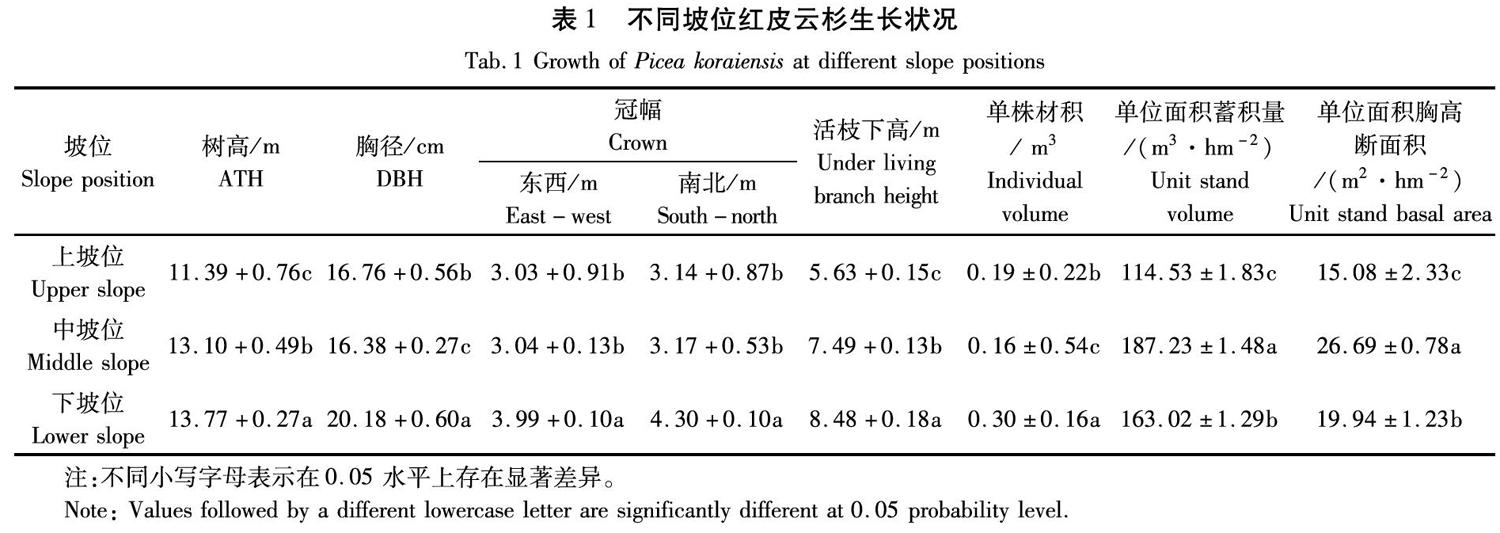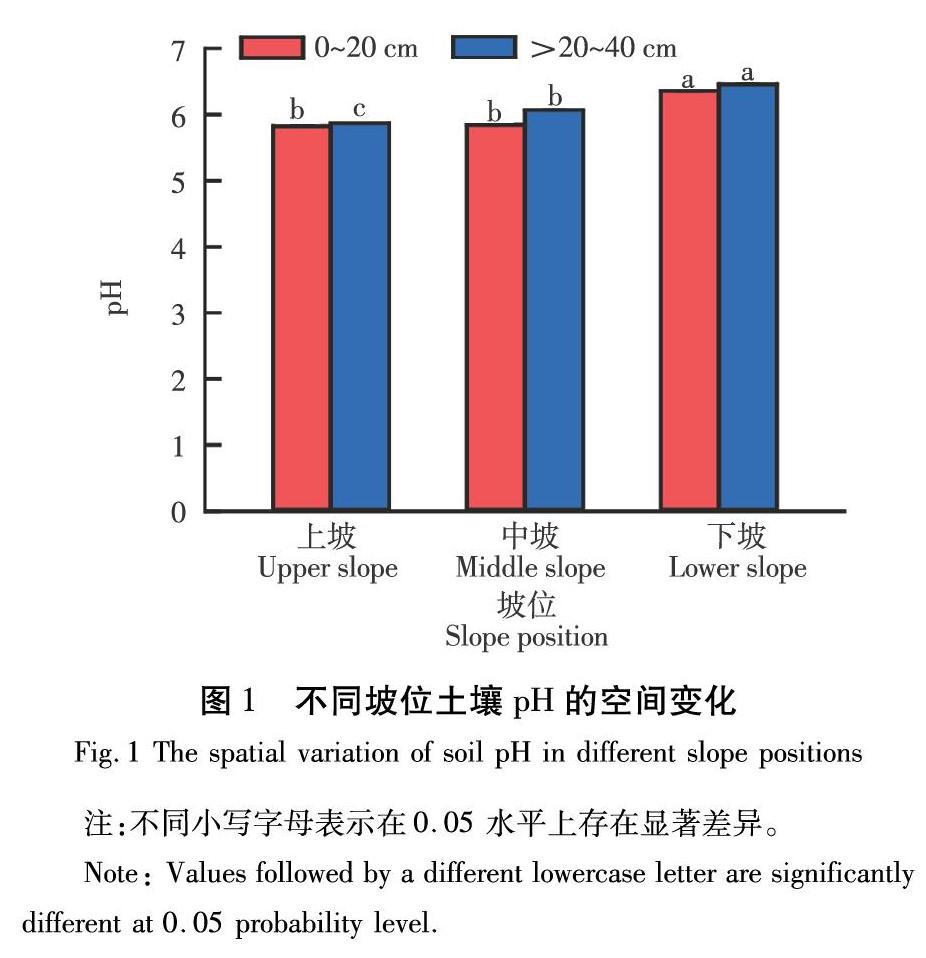不同坡位红皮云杉林木生长与土壤理化性质比较
2020-04-16苏妮尔沈海龙丁佩军钟兆华徐惠德杨玲
苏妮尔 沈海龙 丁佩军 钟兆华 徐惠德 杨玲



摘 要: 以黑龍江省佳木斯市孟家岗林场43 a红皮云杉人工林为研究对象,测定不同坡位红皮云杉的生长状况和林下土壤理化性质,分析不同坡位红皮云杉人工林林木生长状况和土壤肥沃程度的差异,为建立红皮云杉大径材培育技术提供参考依据。分别在人工林南坡的上、中、下3个坡位上设置样地,调查红皮云杉的树高、胸径、冠幅、活枝下高、单株材积、单位面积蓄积量和单位面积胸高断面积,五点法收集样地不同土层的土壤样品,测定土壤pH和土壤养分(全碳、全氮、全磷、全钾、铵态氮、硝态氮、有效磷和速效钾)含量。对林木生长状况调查发现:不同坡位之间,下坡位的林木生长状况最佳,其树高、胸径、冠幅、活枝下高和单株材积均最大。不同坡位之间,树高、冠幅、活枝下高和单株材积的比较由小到大排序为上坡位、中坡位、下坡位;胸径和单株材积的比较由小到大排序为:中坡位、上坡位、下坡位;单位面积蓄积量和单位面积胸高断面积的比较由小到大排列为:上坡位、下坡位、中坡位。对土壤理化性质分析结果表明,土壤pH随着坡位下降呈增加趋势。不同坡位之间,下坡位的土壤养分含量最高。除了全钾和速效钾的养分含量变化趋势由小到大为:中坡位、上坡位、下坡位外,其余养分含量依次由小到大排列为:上坡位、中坡位、下坡位。对相同坡位土壤养分空间分布的比较发现,林下表层(0~20 cm)土壤养分含量高于较深处(>20~40 cm)土壤。下坡位更有利于红皮云杉林木生长和土壤养分积累,是适合红皮云杉大径材林木培育的有利坡位条件。
关键词: 红皮云杉;大径材培育;坡位;林木生长;土壤养分
中图分类号 :S723.1 文献标识码 :A 文章编号 :1006-8023(2020)02-0006-06
Comparison of Tree Growth and Soil Physical and Chemical Properties
of Picea koraiensis Plantation at Different Slope Positions
SONOR1,SHEN Hailong1,DING Peijun2,ZHONG Zhaohua2,XU Huide2,YANG Ling1*
(1.School of forestry, Northeast Forestry University, Harbin 150040, China;
2.Mengjiagang Forest Farm of Jiamusi of Heilongjiang Province,Jiamusi 154000, China)
Abstract: Taking the 43a Picea koraiensis plantation in Mengjiagang Forest Farm of Jiamusi of Heilongjiang Province as the research object, tree growth and forest soil physical and chemical properties were measured. The differences of growth shape and soil fertility artificial trees at different slope positions were analyzed to provide reference for the establishment of large-sized round wood cultivation technology of P. koraiensis.The sample plots were set up at the upper, middle and lower slopes on the south slope of plantation to investigate the tree height, diameter in breast high of trees (DBH), crown width and living branch height, and the soil samples from different soil layers were collected at five points to determine the soil pH and soil nutrient content (such as total carbon, total nitrogen, total phosphorus, total potassium, ammonium nitrogen, nitrate nitrogen, available phosphorus and available potassium). According to the survey, the trees growth on the downhill slope position was the best among different slope positions, and the tree height, DBH, crown width, living branch height and individual volume were the highest, respectively. Among the different slope positions, the comparison of tree height, crown width, living branch height and individual volume was ranked from small to large as uphill slope position, mid-slope position and downhill slope position. The comparison of breast diameter and individual volume were ranked from small to large as mid-slope position, uphill slope position, downhill slope position. The comparison of the unit area accumulation and the unit area of the chest height area was ranked from small to larege as uphill slope position, downhill position and middle slope position. The results of soil physical and chemical properties analysis showed that the pH value increased with the decrease of slope positions. The soil nutrient
content of the downhill slope position was the highest among different slope positions. In addition to the change trend of nutrient content of total potassium and available potassium was ranked from small to large as mid-slope position, uphill slope position and downhill slope position. The other nutrient contents were ranked from small to large as uphill slope position, mid-slope position and downhill slope position. Comparing the spatial distribution of soil nutrients on the same slopes, it was found that the soil nutrient content in the lower layer (0-20 cm) was higher than that in the deeper (>20-40 cm).The downhill slope position is more favorable for the tree growth of P. koraiensis and soil nutrient accumulation, which is suitable for the cultivation of P. koraiensis trees with large-sized round wood cultivation.
Keywords: Picea koraiensis; large-sized round wood cultivation; slope position; tree growth; soil nutrients
0 引言
在森林生態系统中,地形是决定土壤与环境进行物质循环的重要因子[1]。在同一地区的不同坡位会使土壤肥力和土壤水分产生生态梯度变化,且不同坡位土壤养分以及水分分布的差异主要由大气作用、土壤性质和降雨过程中养分流失造成[2]。从20世纪开始,研究者们开始了地形因子对土壤肥力、林木生长、林木根系形态的研究[3-4]。邓继峰等[5]研究发现,油松(Pinus tabuliformis)和樟子松(Pinus sylvestrisvar)林下土壤养分会集中于坡位相对较低处的现象,表明低坡位能积累林木生长所需的养分。韦建宏等[6]研究表明土壤养分在上中下坡位的含量排列由大到小依次为:下坡位、中坡位、上坡位。从土壤的空间垂直分布上来说,随着土层加深土壤养分会有下降趋势,是由于凋落物淋洗和分 解过程中为表层输入了很多养分[7-8]。通过对土壤养分相关性分析发现,土壤全量养分和速效养分均呈显著正相关关系。说明土壤养分在相同的环境条件下具有较强的空间相关性,各养分之间随着含量和组合的改变而出现变化[9]。土壤是林木生长所需物质的提供者,不同的养分组成和含量都会对林木的生长带来不同的影响[10]。有很多研究指出林木的生长会在米级差异上表现不同[11-12]。Hoylman等[13]得出30 m以下的针叶树在不同坡位上的年生长量有显著差异,这是由于上坡位与下坡位相比对于大气的需求要大,但风的作用会使上坡位水分短缺,从而导致在上坡位位置树木年生长率会相对于下坡位低。
红皮云杉(Picea koraiensis)是我国东北营造速生丰产林的珍贵树种,有耐阴、耐旱和耐贫瘠的特征。立地条件可显著影响红皮云杉林木的生长。人们研究发现,红皮云杉在氮、磷和钾含量高且水分充足,但没有积水的立地条件下会有更大生长空间[14],但在向阳和山顶位置则生长缓慢[15]。本研究以黑龙江省佳木斯市孟家岗林场的43 a红皮云杉人工林为研究对象,调查不同坡位红皮云杉的生长状况和土壤养分的空间特征差异,以筛选出适合红皮云杉大径材林木培育的适宜坡位条件,为建立红皮云杉大径材培育技术提供科学依据。
1 研究地概况与研究方法
1.1 研究地概况
研究地点位于黑龙江省佳木斯市孟家岗林场 (130°32″42′~130°52″36′E,46°20″16′~46°30″50′N), 海拔170~575 m,土壤类型主要为暗棕壤,属于中温带大陆性季风气候,年均气温为2.7 ℃,最高气温达35.6 ℃, 最低温度达-38.6 ℃,年均降雨量为550 mm,无霜期为120 d左右,全年日照时数为1 955 h。
1.2 样地设置与调查
2018年5月分别在坡度为7°~8°的43 a红皮云杉人工林南坡的上、中、下位置随机设置50 m×50 m的样方,每个坡位重复3个样方。上、中、下坡位的海拔分别为305、287、270 m,样地内郁闭度为0.9,上中下坡位林分密度分别为592、1 164、560株/hm2。 上、中、下坡位共有的优势树种有红皮云杉(Picea koraiensis)、色木槭(Acer mono)、水曲柳(Fraxinus mandshurica)、蒙古栎(Quercus mongolica)和胡桃楸(Juglans mandshurica)。坡中特有的树种有白桦(Betula platyphylla)和黑桦(Betula dahurica);坡下特有的树种有榛子(Corylus heterophylla)和榆树(Ulmus pumila)。在所有样地里主要灌木层树种有刺五加(Acanthopanax senticosus)、忍冬(Lonicera japonica)、平榛(Corylus heterophylla)、接骨木(Sambucus williamsii)和暴马丁香(Syringa amurensis);草本有堇菜(Viola verecunda)、问荆(Equisetum arvense)、铃兰(Convallaria majalis)、蔷薇(Rosa spp.)、苔草(Carex spp.)和蚊子草(Filipendula Palmata)等。
1.3 土壤理化性质的测定
采用五点法用土钻取出0~20 cm层和20~40 cm层的 土壤样品并用四分法将样品分成两份,一份放进4 ℃冰箱保鲜,用连续流动分析仪进行铵态氮和硝态氮含量的测定。另一份自然风干后测定土壤全碳含量、全氮含量、全磷含量、全钾含量、有效磷含量、速效钾含量和土壤的pH。其中,全碳含量和全氮含量采用Vario Macro元素分析仪测定;全磷含量和全钾含量用高氯酸和浓硫酸消煮后分别用钼锑抗比色法和火焰光度计法测定;有效磷含量用双酸提取后采用钼锑抗比色法测定;速效钾含量用中性醋酸铵浸提后用火焰光度计测定,pH采用电位测定法(水土质量比为2.5∶ 1)[16-17]。
1.4 统计方法
用Microsoft Excel 2010进行数据处理,IBM SPSS Statistics 21 统计分析软件进行单因素方差分析,SigmaPlot 12.5 软件进行(SYSTAT公司)绘图。
2 结果与分析
2.1 不同坡位红皮云杉生长状况比较
由表1可知,不同坡位对红皮云杉林木生长的影响有较大差异。不同坡位上红皮云杉生长状况总体趋势从大到小依次为:下坡位、中坡位、上坡位。树高、活枝下高和冠幅均随着坡位下降而增加。林木胸径和单株材积在下坡位最大,在中坡位最小。下坡位的树高分别比上坡位和中坡位的高出20.90%和5.11%,胸径分别高出21.55%和23.20%,东西冠幅分别高出31.60%和31.25%,南北冠幅分別高出36.94%和35.64%,活枝下高分别高出50.62%和13.22%,单株材积分别高出57.89%和87.50%。单位面积蓄积量和单位面积胸高断面积在中坡位最高,在上坡位最低,中坡位单位面积蓄积量分别高出上坡位和下坡位63.58%和14.85%,单位面积胸高断面积分别高出上坡位和下坡位76.99%和33.85%%。从方差分析和多重比较结果可知,不同坡位之间树高、胸径、活枝下高、单株材积、单位面积蓄积量和单位面积胸高断面积差异显著(P<0.05),下坡位东西和南北冠幅显著高于上坡位和中坡位(P<0.05)。
2.2 不同坡位土壤pH与土壤养分的空间变化
由图1可知,不同坡位的土壤pH平均值均呈弱酸性,数值范围为5.80~6.46。不同坡位相同土层的土壤pH由大到小排序为:下坡位、中坡位、上坡位。在相同坡位上土壤pH表现为0~20 cm土层的低于>20~40 cm土层。从方差分析和多重比 较结果可知,下坡位0~20 cm土层和>20~40 cm土层的土壤pH显著高于中坡位和上坡位(P<0.05)。
不同坡位土壤全量养分空间变化见表2和图2。由表2和图2可知,不同坡位之间土壤全量养分含量有较大区别,下坡位的养分含量比上坡位和中坡位的高。 在两个土层中,不同坡位的全碳、全氮和全磷 含量由大到小依次为:下坡位、中坡位、上坡位,而全钾含量在下坡位最高,中坡 位最小。从相同坡位不同土层 的全量养分 含量来看,0~20 cm土层的均高于>20~40 cm土层。下坡位两个土层中全碳含量比上坡位和中坡位分别高出 61.50%、232%和33.60%、116.00%(P<0.05);全氮含量高出上坡位和中坡位47.20%、208.30%和29.30%、105.60%(P<0.05),全磷含量高出上坡位和中坡位135.20%、211.40%和121.90%、174.00%(P<0.05),全钾显著高出上坡位和中坡位31.90%、29.30%和32.80%、51.50%(P<0.05)。
由表3可知,不同坡位相同土层的速效养分含量与全量养分含量具有相同的变化趋势,依次由大到小排列为:下坡位、中坡位、上坡位,同一坡位不 同土层的速效养分含量均为上层(0~20 cm)土壤养分含量高于下层的(>20~40 cm)。在上、中、下坡位中,0~20 cm土层的铵态氮含量比>20~40 cm 土层的分别高出16.90%、18.50%、71.50%,硝态氮含量比>20~40 cm土层的分别高出30.20%、43.90%、28.70%,有效磷含量比>20~40 cm土层的分别高出268.00%、 217.00%、308.00%,速效钾含量比>20~40 cm土层的分别高出3.90%、3.11%、0.90%。两种速效氮的含量相比较,不同坡位和不同土层中的硝态氮含量均显著高于铵态氮含量(P<0.05)。
3 讨论与结论
3.1 不同坡位红皮云杉生长状况
红皮云杉易成活易成林,有较强的适应不同立地条件的能力,但在不同立地和气候条件下会有不同的生长速度和产量[18]。这与红皮云杉自身的生物学特性相关,在平坦、土壤肥厚、无过多积水、土层深厚和湿润温和的条件下生长迅速且丰产[19]。尽管红皮云杉适应性强,但在不同的坡向和坡位上生长状况会有很大差异[20-21]。朱虹等[14]研究发现坡位是仅次于土壤因素的第二关键因子。由于不同地形所处的光照和温度有差异,会使其径向生长产生不同的趋势。本次研究中坡位红皮云杉林木胸径生长低于上坡位是由于中坡位林分密度高于上坡位,导致其胸径低于上坡位的状况。虽林分密度大可以提高单株材积和单位面积蓄积量,但林分过密限制了红皮云杉的径向生长,不利于大径材培育;低坡位结合适宜的林分密度可以促进红皮云杉林木胸径生长,其树高、活枝下高和冠幅也有相同的增加趋势。
3.2 不同坡位土壤pH与土壤养分的空间变化
立地条件、环境、水分以及树种间相互竞争均可影响生态系统中能量流动和物质循环。pH的高低会反映土壤的肥沃程度和支配养分的能力,随着土层深度增加,土壤pH会有酸性减弱的趋势,且减弱程度会加强[22-23]。在不同坡位上pH会表现出近似或由大到小排列依次为:下坡位、中坡位、上坡位[6]。
本研究發现,红皮云杉人工林不同坡位或相同坡位不同土层的土壤养分含量呈现一定的变化规律(图2、表2和表3),即土壤养分在坡位高的地方较难积累,而在低坡位土壤全量养分含量和速效养分含量得到积累和增加。红皮云杉人工林土壤养分含量随坡位变化的规律说明坡位是影响红皮云杉人工林土壤养分的重要结构性因素。氮元素和磷元素是反映枝条和针叶生长的关键因子,氮含量和磷含量揭示着土壤的肥力状况,较高的全氮和全磷含量可显著增加林木的生物量[24-27]。本研究发现,红皮云杉人工林土壤中的全氮含量和全磷含量在不同坡位之间差异较大,下坡位显著高于上坡位和中坡位。在相同的坡位上,红皮云杉人工林土壤养分含量随着土壤深度的加深而减少,这与谢红花等[28]研究结果相同。
不同坡位条件下红皮云杉的生长和林下土壤肥沃程度存在差异。坡位对红皮云杉的生长产生了影响,在下坡位其树高、胸径、活枝下高和冠幅等生长指标高于中坡位和上坡位。不同坡位土壤养分含量以下坡位最高,中坡位次之,上坡位最少。因此认为,下坡位置更适合红皮云杉林木径向生长,林木在下坡位置可获得更多生长所需的养分。因此,以红皮云杉大径材培育为目的进行造林时应该选择低坡位和养分含量高的立地条件,下坡位是适合红皮云杉大径材培育的适宜坡位条件。
【参 考 文 献】
[1] SCHWANGHART W, JARMER T. Linking spatial patterns of soil organic carbon to topography: a case study from south-eastern Spain[J]. Geomorphology, 2011, 126(1/2): 252-263.
[2] MEI X M, ZHU Q K, MA L, et al. Effect of stand origin and slope position on infiltration pattern and preferential flow on a Loess hillslope[J]. Land Degradation & Development, 2018, 29(5): 1353-1365.
[3] SMITH L A, EISSENSTAT D M, KAYE M W. Variability in aboveground carbon driven by slope aspect and curvature in an eastern deciduous forest, USA [J]. Canadian Journal of Forest Research, 2017, 47(2):149-157.
[4] JOURGHOLAMI M, RAMINEH A, ZAHEDI AMIRI G, et al. The influence of slope positions on the recovery response of compacted soil properties and enzyme activity in an oriental beech stand in the Hyrcanian forests, Iran[J]. Sustainability, 2019, 11(7): 1940.
[5] 邓继峰,李景浩,宋依璇.等.油松和樟子松人工林不同坡位土壤养分特征及其与生长性状的关系-以辽东地区为例[J].沈阳农业大学学报,2017,48(5):522-529.
DENG J F, LI J H, SONG Y X, et al. Characteristics of soil nutrients and relations with stand growth of Pinus tabulaeformis and Pinus sylvestnis var. mongolica plantations under different slopes in low mountains and hill district of eastern Liaoning Province[J]. Journal of Shenyang Agricultural University, 2017, 48(5): 522-529.
[6] 韦建宏,侯敏,韦添露,等.不同坡位桉树人工林生长和土壤理化性质比较[J].安徽农业科学,2017,45(5):167-169.
WEI J H, HOU M, WEI T L, et al. Comparison on Eucalyptus spp plantation growth and soil physicochemical properties in different slope position[J]. Journal of Anhui Agricultural Sciences, 2017, 45(5): 167-169.
[7] 冯云,马克明,张育新.等.坡位对北京东灵山辽东栎林物种多度分布的影响[J].生态学杂志,2011,30(10):2137-2144.
FENG Y, MA K M, ZHANG Y X, et al. Effects of slope position on species abundance distribution of Quercus wutaishanica community in Dongling Mountain of Beijing [J]. Chinese Journal of Ecology 2011,30(10): 2137-2144.
[8] 李雯靖,王立,赵维俊.等.祁连山青海云杉林土壤养分特征[J].甘肃农业大学学报,2016,51(5):88-94.
LI W J, WANG L, ZHAO W J, et al. Soil nutrient characteristics of Picea crassifolia forest in Qilian Mountains [J]. Journal of Gansu Agricultural University, 2016, 51(5):88-94.
[9] 李奕,满秀玲,蔡体久.等.大兴安岭山地樟子松天然林不同坡位土壤养分特征及相关性研究[J].安徽农业科学,2014,42(5):1413-1416.
LI Y, MAN X L, CAI T J, et al. Research on soil nutrient characteristic and correlation in different slope position of scotch pine forest in Da Hinggan Mountains[J]. Journal of Anhui Agri Sci, 2014,42(5):1413-1416.
[10] 张少康,刘海威,焦峰.黄土丘陵区微地形梯度下草地群落及土壤对氮、磷添加的响应[J].水土保持研究,2018,25(1):75-83.
ZHANG S K, LIU H W, JIAO F. Responses of grassland communities and soil to nitrogen and phosphorus additions in Micro-topography of the hilly Loess Plateau region[J]. Research of Soil and Water Conservation, 2018, 25(1): 76-83.
[11] HAWTHORNE S, MINIAT C F. Topography may mitigate drought effects on vegetation along a hillslope gradient[J]. Ecohydrology, 2017, 11(1):1-11.
[12] APPELS W M, GRAHAM C B, FREER J E, et al. Factors affecting the spatial pattern of bedrock groundwater recharge at the hillslope scale[J]. Hydrological Processes, 2015, 29(21): 4594-4610.
[13] HOYLMAN Z H, JENCSO K G, HU J, et al. Hillslope topography mediates spatial patterns of ecosystem sensitivity to climate[J]. Journal of Geophysical Research: Biogeosciences, 2018, 123(2): 353-371.
[14] 朱虹,杨凯.红皮云杉人工林立地分类与质量评价[J].东北林业大学学报,2008,36(5):4-6.
ZHU H, YANG K. Site classification and quality appraisal of Picea koraiensis plantations[J]. Journal of Northeast Forestry University, 2008, 36(5): 4-6.
[15] 王建宇, 王庆贵, 闫国永, 等. 原始云冷杉、红松林树木生长对氮沉降的响应[J]. 北京林业大学学报, 2017, 39(4): 21-28.
WANG J Y, WANG Q G, YAN G Y, et al. Response of tree growth to nitrogen deposition in spruce-fir-Korean pine virgin forest in Lesser Khingan Mountains in northeastern China[J]. Journal of Beijing Forestry University, 2017, 39(4): 21-28.
[16] 陆远鸿,曹昀,许令明.等.鄱阳湖沙化土地植物-凋落物-土壤化学计量特征[J].生态学杂志,2019,38(2): 329-335.
LU Y H, CAO Y, XU L M, et al. Stoichiometric characteristics of plants, litter and soils in desertification area of Poyang Lake[J]. Chinese Journal of Ecology, 2019, 38(2): 329-335.
[17] 黄庆阳,曹宏杰,王立民.等.五大連池火山熔岩台地植物多样性与土壤养分的关系[J].浙江农林大学学报,2019,36(1):80-87.
HUANG Q Y, CAO H J, WANG L M, et al. Species diversity and soil nutrients in lava platforms of Wudalianchi Volcanoes, China[J]. Journal of Zhejiang A & F University, 2019, 36(1): 80-87.
[18] 姚启超,王晓春,肖兴威,等.小兴安岭红皮云杉年轮-气候关系及其衰退原因[J].应用生态学报,2015,26(7):1935-1944.
YAO Q C, WANG X C, XIAO X W, et al. Climate-growth relationships of Picea koraiensis and causes of its recent decline in Xiaoxingan Mountains, China[J]. Chinese Journal of Applied Ecology, 2015, 26(7):1935-1944.
[19] 周磊,王樹力.树种混交对红皮云杉人工林土壤养分的影响[J].东北林业大学学报,2019,47(2):39-43.
ZHOU L, WANG S L. Effects of mixed tree species on soil nutrients in Picea koraiensis plantations[J]. Journal of Northeast Forestry University, 2019, 47(2): 37-41.
[20] 袁景荣,尚艳文.嫩江云杉与红皮云杉幼苗生长及物候期观测[J].东北林业大学学报,2008,36(5):13-14.
YUAN J R, SHANG Y W. Growth and phenological observation of Picea koraiensis and Picea koraiensis var. nenjiangensis[J]. Journal of Northeast Forestry University, 2008, 36(5): 13-14.
[21] 王福德,翁海龙,周显昌.红皮云杉优良家系选择方法的研究[J].林业科技,2017,42(1):30-31.
WANG F D, WENG H L, ZHOU X C. Study on the selection method of fine family of red spruce[J]. Forestry Science & Technology, 2017, 42(1):30-31.
[22] 江未来.岳麓山坡面林下土壤有机质分布特征研究[J].邵阳学院学报(自然科学版),2018,15(3):82-87.
JIANG W L. Reseach on distribution characteristics of soil organic matter on woodland slope of Yuelu Mountain[J]. Journal of Shaoyang University(Natural Science Edition), 2018, 15(3): 82-87.
[23] 郭汉清,张勇,李特.等.关帝山典型针叶林土壤理化性状研究[J].山西农业大学学报(自然科学版),2014,34(2):162-167.
GUO H Q, ZHANG Y, LI T, et al. Study on the soil physicochemical properties of coniferous forests in Guandi Mountain[J]. Journal of Shanxi Agricultural University(Natural Science Edition), 2014, 34(2): 162-167.
[24] 陈彩虹,田大伦,方晰.等.城郊4种人工林林下植被物种多样性、生物量与土壤养分相关性[J].水土保持学报,2010,24(6):213-217.
CHEN C H, TIAN D L, FANG X, et al. Correlativity between undergrowth vegetation species diversity/biomass and soil fertility of four types planted forest in suburbs[J]. Journal of Soil and Water Conservation, 2010, 24(6):213-217.
[25] 李慧,王百田,曹远博.等.吕梁山区3种人工林植被、凋落物生物量差异特征及其与土壤养分的关系[J].植物研究,2016,36(4):573-580.
LI H, WANG B T, CAO Y B, et al. Difference feature of planted vegetation biomass and litter biomass for three plantations and their relationship with soil nutrients in Lvliang Mountainous region[J]. Bulletin of Botanical Research, 2016, 36(4): 573-580.
[26] TU L H, PENG Y, CHEN G, et al. Direct and indirect effects of nitrogen additions on fine root decomposition in a subtropical bamboo forest[J]. Plant and Soil, 2015, 389(1/2): 273-288.
[27] 张扬,裴亚蒙,任昊晔,等.模拟氮沉降对长白山兴安落叶松林土壤有机碳库的短期影响[J].林业科技,2019,44(3):22-25.
ZHANG Y,PEI Y M, REN H Y,et al. Response of soil total organic carbon and its fractions to short-term simulated nitrogen deposition in a Larix gmelinii plantation in Changbai Mountains[J]. Forestry Science & Technology, 2019, 44(3): 22-25.
[28] 谢红花,李超,钱晔.等.云南乌蒙山区土壤养分空间变异及海拔梯度分布规律[J].中国农学通报,2018,35(8):52-58.
XIE H H, LI C, QIAN Y, et al. Spatial variability and altitudinal gradient distribution pattern of soil nutrients in Wumeng Mountainous region, Yunnan[J]. Chinese Agricultural Science Bulletin, 2018, 35(8): 52-58.
